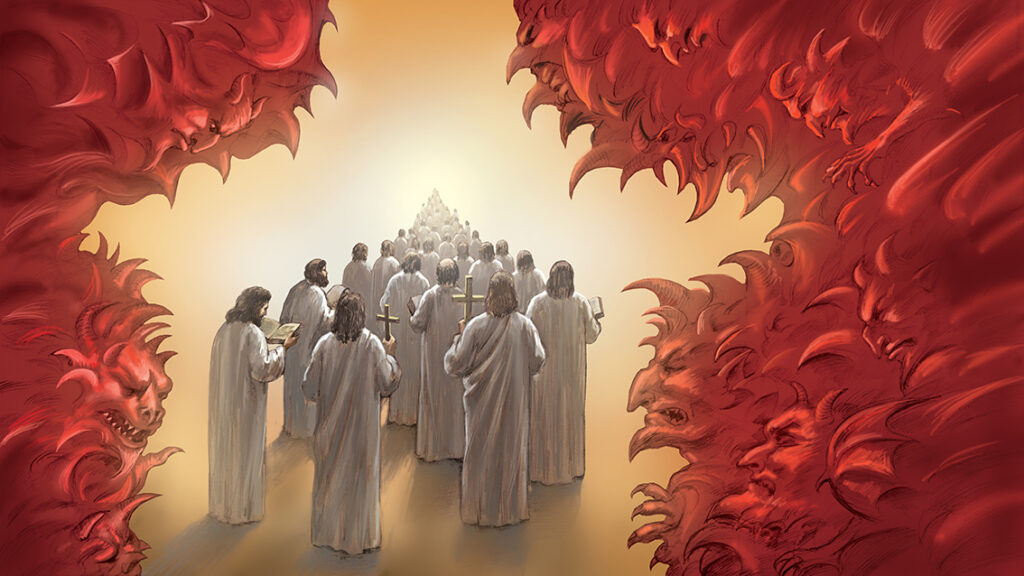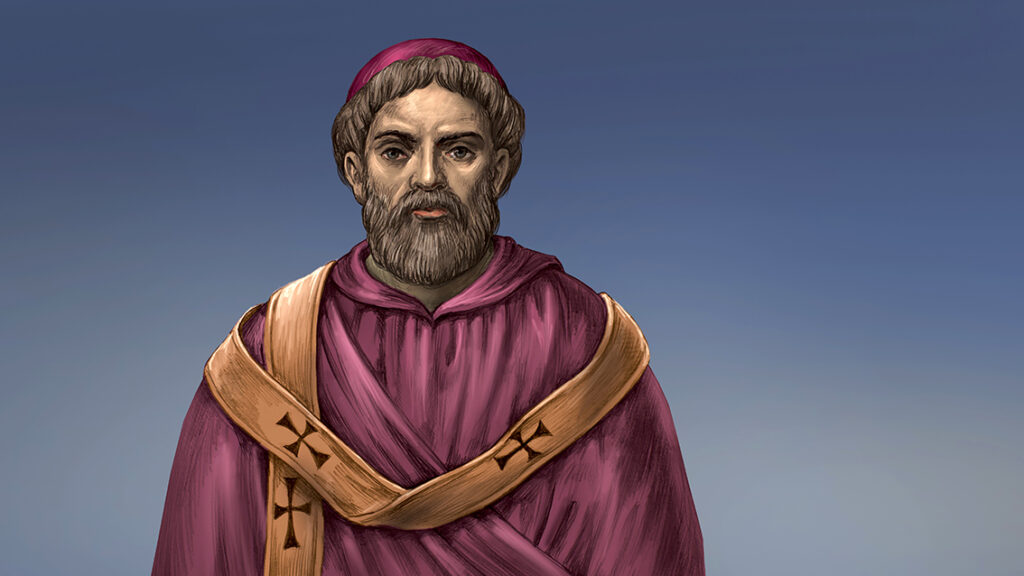
12. A Time, Times, and Half a Time
Dan 7:25, Dan 8:9-14, Dan 12:5-13
The Protestants in the 18th century understood the “time, times, and half a time” in Dan 7:25 as the time when the saints were placed in the hands of the pope, the bishop of Rome. Most of the Protestants at that time believed this began when the bishop of Rome gained full status as a “temporal prince” in the 8th century.
However, the Catholics disagreed with the Protestants’ view of the beginning of the pope’s power. They cited the letters of excommunication that the bishop of Rome wrote to the churches of Asia in 193 as proof that the primacy of the bishop of Rome had begun much earlier.
Already, in the 1st century, the apostle John warned of the coming of the Antichrist, saying, “This is the last hour.”1 John 2:18 Forty years later, Justin Martyr said, “He whom Daniel foretells would have dominion for a time, and times, and a half, is even already at the door, about to speak blasphemous and daring things against the Most High.”1
He shall exalt himself as high as the Captain of the Armies, and by him the daily sacrifices were taken away, and the place of his sanctuary was cast down
Daniel 8:11
The event that began the “time, times, and half a time” was described in Dan 12:11: “From the time that the daily sacrifice is taken away and the abomination of desolation is set up, there shall be 1,290 days.” This was 3 ½ years or 43 months of 30 days on the Jewish lunar calendar.
The sin that caused desolation and the taking away of the daily sacrifice was described in Dan 8:11: “He shall exalt himself as high as the Captain of the Armies, and by him the daily sacrifices were taken away, and the place of his sanctuary was cast down.”
Indeed, the letters of excommunication written by the bishop of Rome in 193 marked the start of the “time, times, and half a time.” When the bishop of Rome wrote the letters of excommunication to the churches of Asia, he exalted himself as high as the Captain of the Armies, as high as Christ.
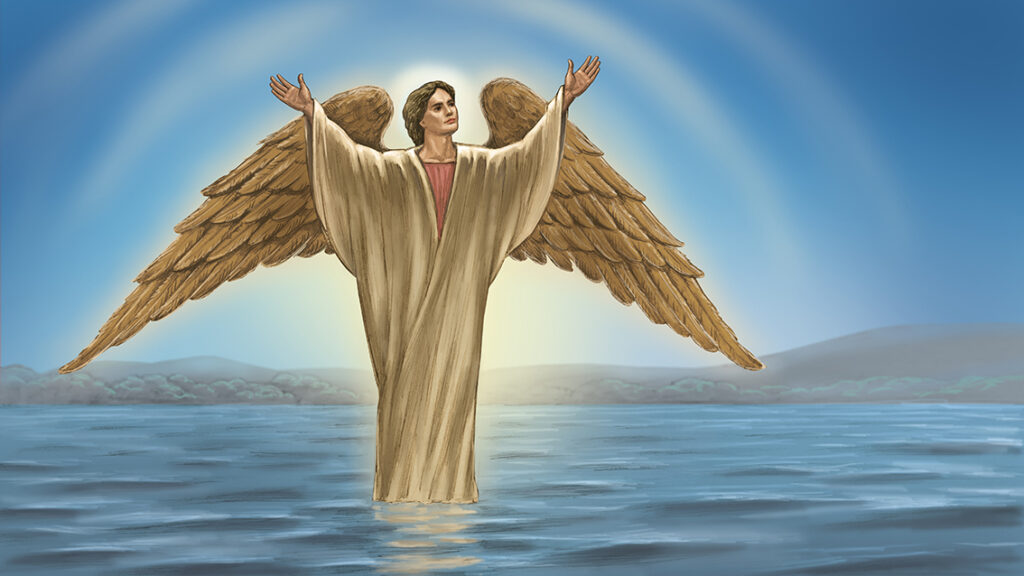
13. Exactly a Time, Times, and Half a Time
An angel told Daniel the Antichrist will “wear out the saints of the Most High, and they shall be given into his hand for a time, times, and half a time.” In 135, Justin Martyr said the Jews of his day believed that “time, times, and half a time” meant time plus two times plus half a time, and they thought this would be at least 350 years: 100 years plus 200 years plus 50 years.2
But no one in Justin Martyr’s Day could have imagined that “a time, times, and half a time” was 3 ½ years in days, with each day representing one year!
In Daniel’s last chapter, we are told that the saints will be given into Satan’s hand for exactly “a time, times, and half a time.” One angel asks another, “How long shall it be to the end of these wonders?”
Then I heard the man clothed in linen, who was above the waters of the river, when he held up his right hand, and his left hand to heaven, and swore by Him who lives forever, that it shall be for a time, times, and half a time…
Daniel 12:7
Three and a half years is 1,278 days. A year is 365.25 days; when multiplied by 3 ½, this gives us exactly 1,278 days.
At the end of Daniel 12, an angel used the months of the Jewish lunar calendar to give us 1,290 days. In 3 ½ years, there are 43 months of 30 days. In the Book of Revelation, the angel used the solar calendar of the Romans to give us 42 months of 30 days, or 1,260 days. The exact number of 1,278 days lies between Daniel’s 1,290 days and John’s 1,260 days.
These 1,278 days began when the bishop of Rome exalted himself as high as Christ in 193, and ended in 1471, when the Moravian Church escaped from his hand.
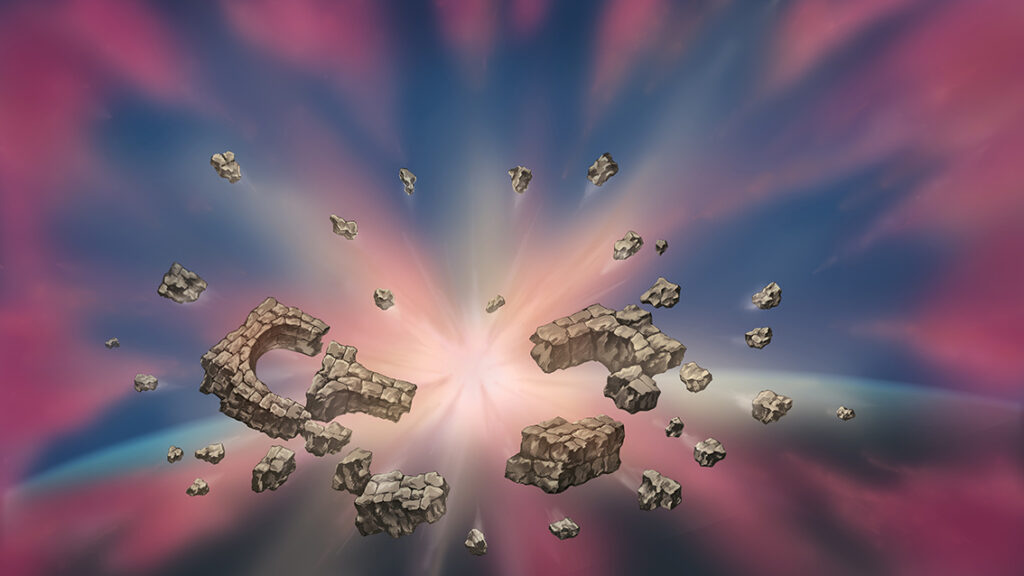
14. The Sin that Caused Desolation
Dan 7:8, Dan 8:11-12, Dan 11:36, 2 Thess 2:4
Daniel described the coming of the bishop of Rome (the pope), saying, “He shall exalt and magnify himself above every god.”Dan 11:36 The apostle Paul described him as the one “who opposes and exalts himself above every so-called god or object of worship such that he sits in the temple of God, displaying himself as being God.”2 Thess 2:4
His sin was explained in Dan 8:11: “He even exalted himself as high as the Prince of the Host; and by him the daily sacrifices were taken away, and the place of His sanctuary was cast down.”
The Hebrew word translated as “Prince” is Sar. It means Captain. The Hebrew word translated as “Host” is Tsaba. It means Armies. The Prince of the Host was the Captain of the Armies of the Lord, the angel who appeared to Joshua and Moses and told them to take the sandals off their feet. He was the pre-existent Christ.
who opposes and exalts himself above every so-called god or object of worship such that he sits in the temple of God, displaying himself as being God
2 Thessalonians 2:4
How did Satan exalt himself as high as Christ so that the place of his sanctuary was cast to the ground?
Daniel said he was given “two eyes and a mouth.”Dan 7:8 Satan’s power became as great as Christ’s when the bishop of Rome wrote letters of excommunication to the churches of Asia in 193 because the churches of Asia disagreed with his Easter Sunday doctrine.
The idea that the bishop of Rome had the aforesaid authority can be found in Irenaeus’s book Against Heresies written in 180. Irenaeus wrote, “The very ancient and universally known church founded and organized at Rome by the two most glorious apostles, Peter and Paul – the faith preached to men, which comes down to our time by means of the successions of the bishops. It is a matter of necessity that every church should agree with this church, on account of its preeminent authority.”3
The bishop of Rome claimed that he had the authority to determine the teachings of the Church. He was the new Lord of the Church.
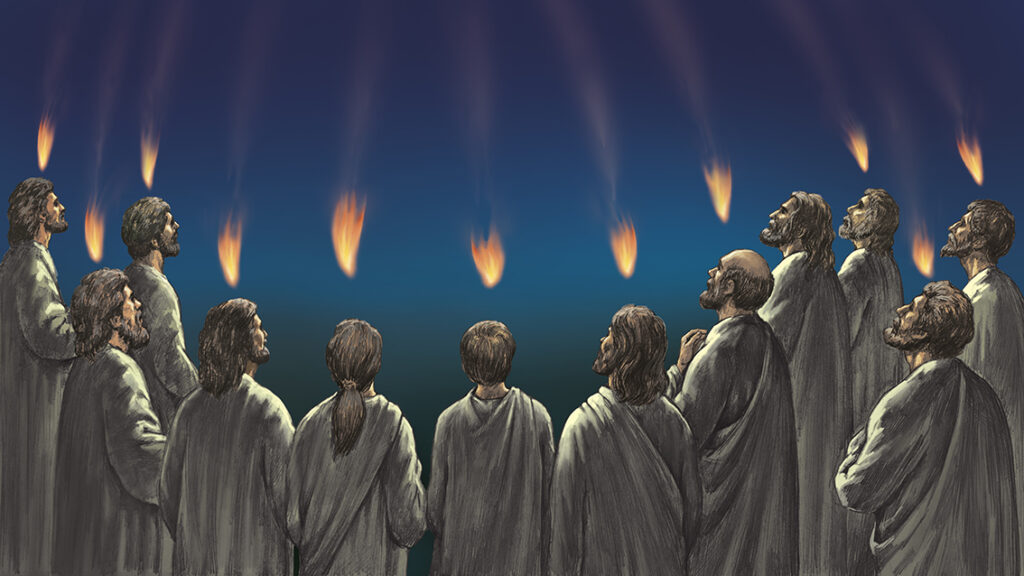
15. His Sanctuary Was Cast Down
In 193, the bishop of Rome exalted himself as high as Christ by excommunicating the churches of Asia, and the spirit of truth was taken away. The place of God’s sanctuary was cast down. The Church no longer obeyed the teachings of Christ and instead obeyed the teachings of the bishop.
The spirit of God is the spirit of truth. For the Church to receive the spirit of truth, it must obey the commandments of Christ and the teachings of the apostles. The sanctuary of God’s Church is the dwelling place of His spirit.
The spirit of God was first received on the Day of Pentecost, as evidenced by speaking in tongues. The apostle Paul described this in his letter to the Corinthians. In about A.D. 90, Bishop Clement of Rome also wrote to the Corinthians, saying, “A full outpouring of the holy spirit was upon you all.”4
For they heard them speak with tongues and magnify God
Acts 10:46
In 180, Irenaeus gave us the last testimony of receiving the holy spirit. He wrote:
“For this reason does the apostle declare, “We speak wisdom among them that are perfect,” terming those persons perfect who have received the spirit of God and who through the spirit of God do speak in all languages…. In like manner we do also hear many brethren in the Church who possess prophetic gifts and who through the spirit speak all kinds of languages.”
Against Heresies, Book 5, Chapter 6, paragraph 1
After Irenaeus wrote this testimony in his book Against Heresies, a false experience of speaking in tongues began with a cult called Montanism.
The mainstream church believed that the Montanists were possessed by evil spirits. In 324, Eusebius quoted the writing of a commentator in the day who said that their founders, Montanus and Maximillia, “died a different death—a mind-destroying spirit driving each to a separate suicide.”5

16. The Daily Sacrifices Were Taken Away
Dan 8:11, Dan 11:31, Dan 12:11, John 20:22-23
In Daniel 8, an angel explained that when the place of God’s sanctuary was cast to the ground, “the daily sacrifice was taken away.”
The Hebrew word for “the daily sacrifice” is hattamid (התמיד). The same word is also used in Dan 11:31 and Dan 12:11 to describe the daily sacrifice that was taken away when the abomination of desolation was set up. The tamid (תמיד) is the offering that is constantly before God.
The blood of Christ is the daily sacrifice that stands before God to atone for our sins. When we are baptized, the blood of Christ washes away our sins, as described in Acts 2:38 and Acts 22:16.
Jesus gave His disciples the authority to remit sins when He breathed His Spirit on them, saying, “Receive the holy spirit. If you forgive the sins of any, their sins are forgiven.”John 20:22-23
Receive the holy spirit. If you forgive the sins of any, their sins are forgiven
John 20:22-23
However, when the spirit of God was taken from the Church, there was no evidence that the Church still had the authority to wash away sins in baptism.
This power of the daily sacrifice was taken away.
Despite this, the bishop of Rome still claimed to have the authority to remit sins simply because of his position as the bishop of Rome. Martin Luther said that this was a lie from the pope, and called the pope the Antichrist:
“The pope is the very Antichrist, who has exalted himself above and opposed himself against Christ because he will not permit Christians to be saved without his power, which, nevertheless, is nothing and is neither ordained nor commanded by God.”
Smalcald Articles II, IV, 10-14
Even now, Protestant churches do not claim to have the authority to remit sins through baptism. They believe that baptism is only symbolic, and for this reason, they pay little attention to the method of baptism.
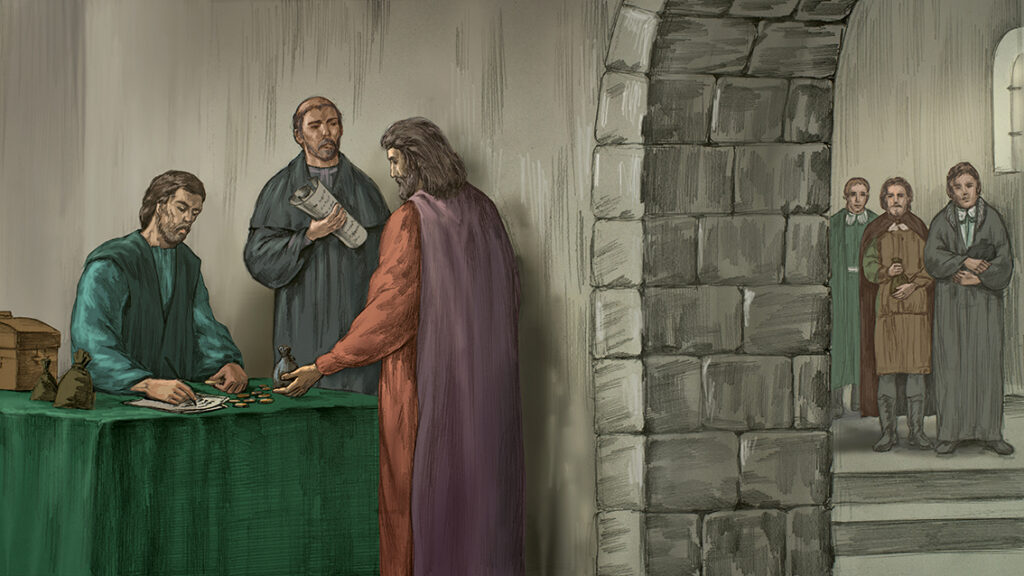
17. He Cast Truth to the Ground
Dan 7:25, Dan 8:11, Dan 12:7, Rev 11:2
Daniel’s prophecy of the death of the Messiah after 3 ½ years is our first hint of the meaning of “a time, times, and half a time.” Just as Christ taught the Gospel in 3 ½ years, the Antichrist corrupted it in 3 ½ years, but in days as years: 1,278 days, as years.
Jesus said that the Gentiles would trample the Holy City underfoot until the time of the Gentiles was fulfilled. In Rev 11:2 we read, “They shall trample the Holy City underfoot for forty-two months.”
In Daniel 7, an angel described the work of the Antichrist through the bishop of Rome and the Gentiles: “He shall wear out the saints of the Most High, and they shall be given into his hands for a time, times, and half a time.” In Daniel 12, the Messenger said: “It shall be a time, times, and half a time; and when the power of the holy people has been completely shattered, all these things shall be finished.”Dan 12:7
He cast truth to the ground.
Daniel 8:12
Easter Sunday was only one of the many new doctrines enforced by the bishop of Rome. The angel described this in Daniel 8, saying, “He shall cast truth to the ground.”Dan 8:11 Many of the new teachings of the Church, including the change in the method of baptism and the Trinity doctrine, came from the Montanists and their chief spokesman, Tertullian, the father of Latin Christianity. Tertullian and the Montanists were possessed by demons, the army of demons prophesied by Daniel. Tertullian called Montanism the “New Prophecy” and said that the holy spirit was now explaining all the perplexities in the Bible.
By the time of the Reformation, the corruption of doctrine had become unparalleled. The Church even sold the forgiveness of sins, called “indulgences.” The power of the Holy people was completely shattered before the Spirit of Christ, the Rock, shattered the beast.
18. the great tree
The clearest explanation of the abomination of desolation is found in the fourth chapter of Daniel.
King Nebuchadnezzar had a vision of a great tree that “could be seen to the ends of all the Earth … and the birds of the air came and rested in its branches.”Dan 4:11-12
An angel commanded, “Chop down the tree and cut its branches … Let the beasts get out from under it, and the birds from its branches. Nevertheless, leave the stump and the roots in the Earth bound with a band of iron and bronze.”Dan 4:13-14
God’s Kingdom was chopped down, and a band of iron and bronze was placed around it so it could regrow later. This was just another way of describing the desolation of the Church. The beasts in the Old Testament symbolize the Gentiles, the nations that had not been sanctified, not set apart by God. They were sent out of the tree.
The Birds of the air come and nest in its branches
Matthew 13:32
The angel said that the tree was King Nebuchadnezzar, who must become as a beast in the field until seven times pass over him,Dan 4:16 “a time, times, and half a time,” and he must remain as a beast so that the living may know that the Most High rules in the kingdom of men.Dan 4:17
King Nebuchadnezzar as the king of Babylon symbolized the king of Mystery Babylon, whose kingdom is the “kingdom of the beast” in the Book of Revelation.
Jesus called the corrupted kingdom of heaven a great tree in Matthew 13, and said that the birds of the air represented the workers of Satan.
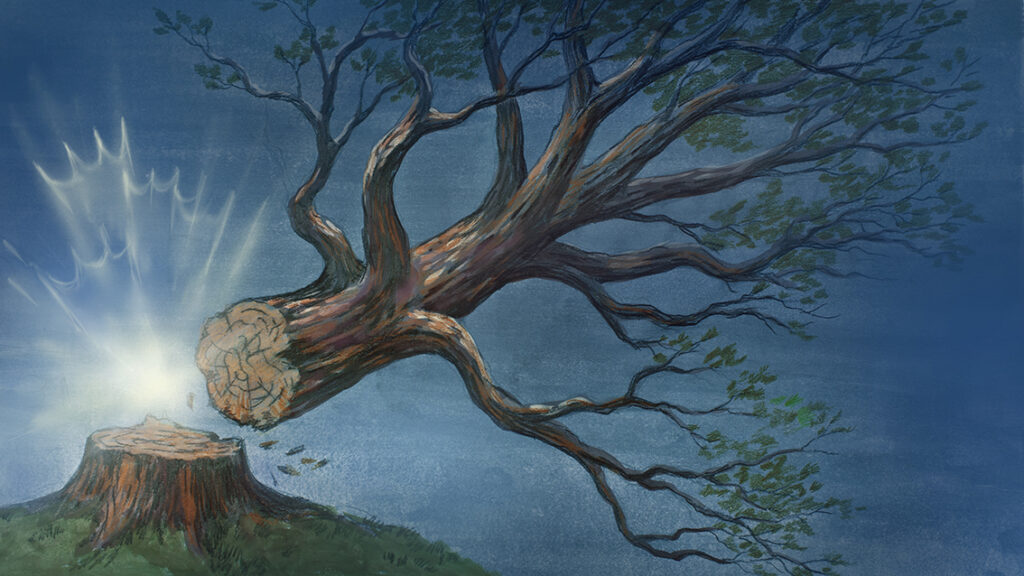
19. The Mountain of the Lord’s House
The abomination of desolation is the central message of the Book of Daniel. It begins in the second chapter.
King Nebuchadnezzar had a dream of an image of gold, silver, bronze, and iron that was struck on its ten toes, which were partly iron and partly clay. This stone “became a great mountain that filled the whole Earth.”Dan 2:35
The Protestant Reformers understood that King Nebuchadnezzar represented the beast and that the ten toes were the states of Europe held together by the “beast.” They also knew that the stone that struck the image was Christ, and that the great mountain was the mountain of the Lord’s house described by Isaiah.
It seems, however, that they did not try to answer this question: If the stone that broke the image became the mountain of the Lord’s house, then where was the mountain of the Lord’s house before?
In the last days, the mountain of the Lord’s House will be established above all the mountains
Isaiah 2:2
Of course, we now know that the Lord’s house was desolated by the Antichrist. In 193, the bishop of Rome exalted himself as high as Christ, and the place of His sanctuary was cast to the ground.Dan 8:11
Even though the temple of God was desolated by the Antichrist, the Kingdom of God continued in the wilderness. Daniel said that His kingdom will never be destroyed and that it “shall not be left to other people; it shall break in pieces and consume all these (other) kingdoms, and it shall stand forever.”Dan 2:44
The Kingdom of God continued “in the wilderness.” The Woman, the bride of Christ “flew into the wilderness … away from the presence of the serpent.”Rev 12:14
This is a very significant truth; it tells us that the Kingdom of God carried on invisibly. The salvation plan of God continued. The apostle John told us that the saints “overcame by the blood of the Lamb and the word of their testimony.”Rev 12:11 From here, and the Epistles of Paul, came Martin Luther’s belief in salvation by faith that overcame the power of the Antichrist.

20. Flee to the Mountains
Jesus said, “When you see the abomination of desolation, which was spoken of by Daniel the prophet, standing in the holy place, let those who are in Judea flee to the mountains.”Matt 24:15-16
Here, Matthew adds the comment “Let the reader understand.”Matt 24:15 In other words, we must understand this. Why?
It has everything to do with our salvation.
During the Reformation, the Protestants understood the meaning of the beast, the little horn that came up among the ten kings. They also understood the meaning of “a time, times, and half a time”: the 1,260 years when the saints were under the control of the bishop of Rome.
However, the Protestants did not understand the meaning of the abomination of desolation, the event that began the “time, times, and half a time,” for Daniel told us that the meaning of these words was sealed up until the end times.
When you see the abomination of desolation, which was spoken of by Daniel the prophet, standing in the holy place, let those who are in Judea flee to the mountains.
Matthew 24:15-16
Jesus said that when we see the abomination of desolation, “let those who are in Judea flee to the mountains.”
Judea is the place of the saints; it represents the kingdom of heaven. The saints flew into the Judean wilderness for “a time, times, and half a time,” away from the presence of the serpent.
Today, Jesus is asking the saints to fly to the mountains. When we see the abomination of desolation, when we understand it, we must flee to the mountain of the Lord’s house described in Daniel 2 and Isaiah 2.
Jesus said, “Whoever is on the rooftop must not go down to get the things that are in his house. Whoever is in the field must not turn back to get his cloak.”Matt 24:18
There is nothing more important than our salvation. There is nothing in this world worth hanging onto. The mountain of the Lord’s house is the temple of God, the dwelling place of God in spirit, the end-time ark of salvation.
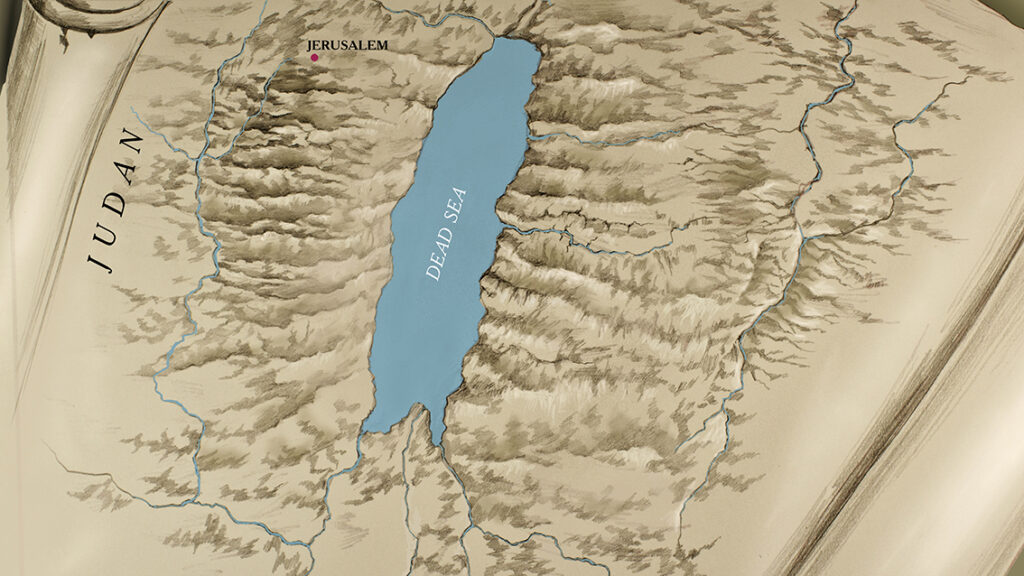
21. The Gospels and Revelation
Once we understand the meaning of the “abomination of desolation,” we will understand all of Jesus’ prophecies in Matthew 24 and Luke 21.
Jesus said, “When you see the abomination of desolation, which was spoken of by Daniel the prophet, standing in the holy place, let those who are in Judea flee to the mountains.”Matt 24:15 — When we “see” the abomination of desolation, we need to flee to the mountain of the Lord’s house to find our salvation.
“When you see Jerusalem surrounded by armies, then know that its desolation is near.”Luke 21:20 — New Jerusalem was surrounded by the army of demons described in Daniel 8 and 11.
“Woe to those who are pregnant and nursing babes in those days.”Matt 24:19 Luke 21:23 — In Revelation 12, we read that the dragon persecuted the elect lady and her children.
They will trample the Holy City underfoot until the time of the Gentiles is fulfilled.
Luke 21:24
“For then there will be a Great Tribulation.”Matt 24:21 — Satan accused the saints day and night.
“And they will fall by the edge of the sword and be led away captive into all nations.”Luke 21:24 — The saints were taken captive by the beast with seven heads and ten horns.
“They will trample the Holy City underfoot until the time of the Gentiles is fulfilled.”Luke 21:24 — This was explained in Revelation 11: “The Gentiles … will trample the Holy City underfoot for forty-two months.”Rev 11:2
“Unless those days were cut short, no flesh would be saved.”Matt 24:22 — No one could be saved by the true Gospel because the Church was desolate of the holy spirit.
But “straight from the tribulation of those days, the sun will be darkened, and the moon will not give its light and the stars will fall.”Matt 24:29 — In the last days, the holy spirit will be poured out again. This is described in the fourth trumpet as the darkening of the sun, moon, and stars, which represent the lawless in the kingdom of heaven.
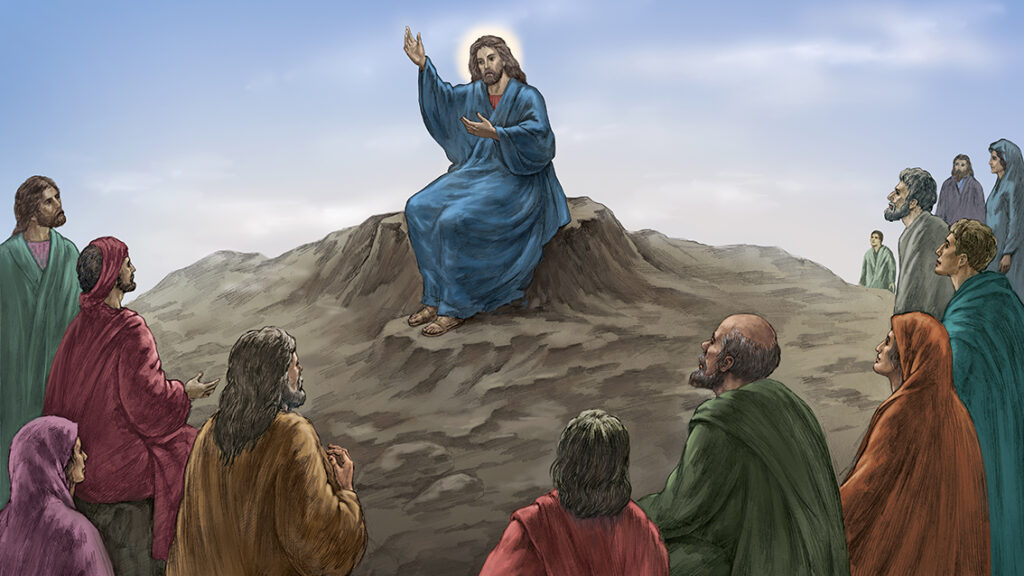
22. The Desolated Church in Revelation
The abomination of desolation is not as obvious in the Book of Revelation as it is in the Book of Daniel.
In Revelation 12, the apostle John only describes the flight of the saints from the desolated church: “The woman fled into the wilderness, away from the presence of the serpent.”Rev 12:14
He concluded Chapter 12 saying, “The dragon was enraged with the woman and went to make war with the rest of her children, who keep the commandments of God and have the testimony of Jesus.”Rev 12:17 This was the war that was described in Dan 9:26 — “Till the end of the war, desolations are determined.”
The meaning of “having the testimony of Jesus” was explained in verse 11: “They overcame because of the blood of the Lamb and the word of their testimony.” After the Church was desolated by the Antichrist, the saints no longer had the testimony of the spirit of God, and they overcame the accusation of Satan by the word of their testimony. The apostle Paul said, “If you confess with your mouth Jesus as Lord and believe in your heart that God raised Him from the dead, you will be saved.”Rom 10:9
They overcame because of the blood of the Lamb and the word of their testimony
Revelation 12:11
In Revelation 19, when the Sanctified Church is restored, the testimony of Jesus is called “the spirit of prophecy.”Rev 19:10 The spirit of prophecy describes the spirit of God in the Targum.
Throughout the Book of Revelation, John describes two groups of saints: the saints of the Great Tribulation and the 144,000. The saints of the Great Tribulation worship God in the tabernacle in the wilderness.Rev 13:6 The 144,000, who have the seal of God on their foreheads, worship God in the Sanctified Church, called “the temple” in Revelation 14–16.Rev 14:15 Rev 15:5 Rev 16:1 They are identified by the sound of many waters and the sound of harps.Rev 14:2 This is the sound of prayer in the holy spirit that Paul described in 1 Cor 14:7.
